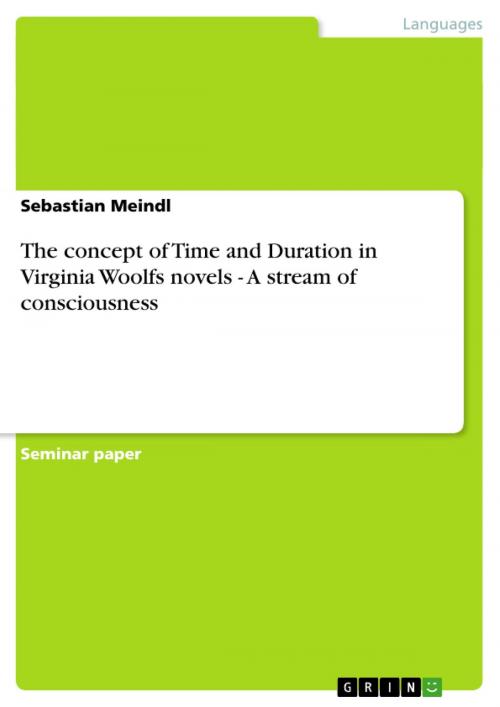The concept of Time and Duration in Virginia Woolfs novels - A stream of consciousness
A stream of consciousness
Fiction & Literature, Literary Theory & Criticism, British| Author: | Sebastian Meindl | ISBN: | 9783640579501 |
| Publisher: | GRIN Publishing | Publication: | March 30, 2010 |
| Imprint: | GRIN Publishing | Language: | English |
| Author: | Sebastian Meindl |
| ISBN: | 9783640579501 |
| Publisher: | GRIN Publishing |
| Publication: | March 30, 2010 |
| Imprint: | GRIN Publishing |
| Language: | English |
Seminar paper from the year 2008 in the subject English - Literature, Works, grade: 2.3, University of Regensburg (Anglistik und Amerikanistik), course: Proseminar Virginia Woolf und Jeanette Winterson, language: English, abstract: 'I believe that all novels, that is to say, deal with character, and that it is to express character- not to preach doctrines, sing songs, or celebrate the glories of the British Empire, that the form of the novels, so clumsy, verbose, and undramatic, so rich and unelastic, and alive, has been evolved. To express character, I have said.' Virginia Woolf made this 'character expressing' to the centre of her work and brought it to perfection in her late novels. She began using a stream technique in Jacob's Room to describe characters' thoughts and feelings. In phase II she built her novels on characters' thoughts, formed the plot through description and characters mind progression. In To The Lighthouse Woolf let the plot progress through the developments of character. The Waves completely relies on the description of the characters' minds and is phase III of her development. 'She reaches perfection in characters' thought and mind description' through the 'stream of consciousness.' The purpose of this work is to cover a basic approach on the stream technique Woolf uses in her novels, as well as embed some text passages in the psychological background William James and Henri Bergson gave in their theories. Bergson and James are both psychologists who gave way to theories oftime and duration, as well as to the theory of consciousness. Bergson, who was senior of William James, was highly influenced by James' work and it is said that Bergson's writing of Les données immédiates de la conscience was influenced by James' article 'On Some Omissions of Introspective Psychology'. Concurrently Bergson was highly regarded by James: 'So modest and unpretending a man but such a genius intellectually! I have the strongest suspicions that the tendency which he has brought to a focus, will end by prevailing,(...)' Consequently it is obligatory to combine Woolf's ideas of character description and her stream technique, with which she provides an insight into the character, with James' and Bergson's work. This can of course not be done in extenso on the following pages but I am trying to give an overview what we can deplore behind the surface of Woolf's work.
Seminar paper from the year 2008 in the subject English - Literature, Works, grade: 2.3, University of Regensburg (Anglistik und Amerikanistik), course: Proseminar Virginia Woolf und Jeanette Winterson, language: English, abstract: 'I believe that all novels, that is to say, deal with character, and that it is to express character- not to preach doctrines, sing songs, or celebrate the glories of the British Empire, that the form of the novels, so clumsy, verbose, and undramatic, so rich and unelastic, and alive, has been evolved. To express character, I have said.' Virginia Woolf made this 'character expressing' to the centre of her work and brought it to perfection in her late novels. She began using a stream technique in Jacob's Room to describe characters' thoughts and feelings. In phase II she built her novels on characters' thoughts, formed the plot through description and characters mind progression. In To The Lighthouse Woolf let the plot progress through the developments of character. The Waves completely relies on the description of the characters' minds and is phase III of her development. 'She reaches perfection in characters' thought and mind description' through the 'stream of consciousness.' The purpose of this work is to cover a basic approach on the stream technique Woolf uses in her novels, as well as embed some text passages in the psychological background William James and Henri Bergson gave in their theories. Bergson and James are both psychologists who gave way to theories oftime and duration, as well as to the theory of consciousness. Bergson, who was senior of William James, was highly influenced by James' work and it is said that Bergson's writing of Les données immédiates de la conscience was influenced by James' article 'On Some Omissions of Introspective Psychology'. Concurrently Bergson was highly regarded by James: 'So modest and unpretending a man but such a genius intellectually! I have the strongest suspicions that the tendency which he has brought to a focus, will end by prevailing,(...)' Consequently it is obligatory to combine Woolf's ideas of character description and her stream technique, with which she provides an insight into the character, with James' and Bergson's work. This can of course not be done in extenso on the following pages but I am trying to give an overview what we can deplore behind the surface of Woolf's work.















